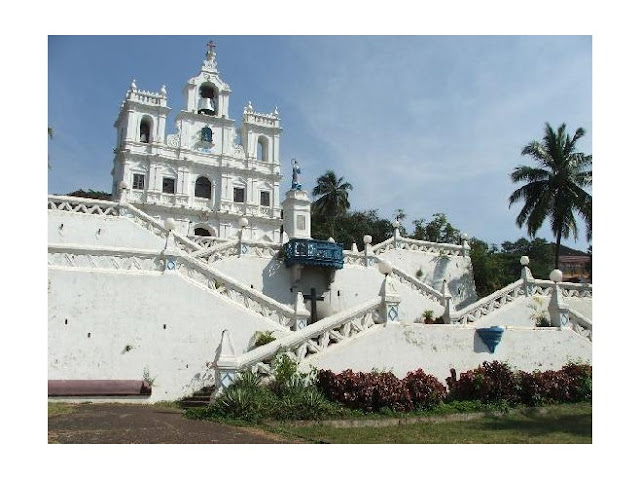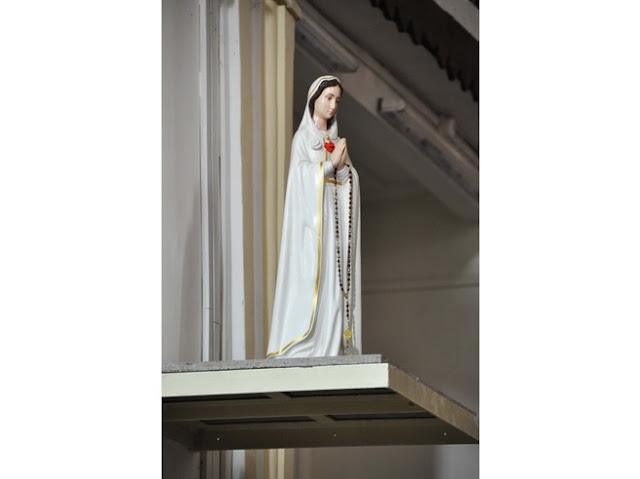The Our Lady of the Immaculate Conception Church, Panjim, Goa, which was first built in 1541 as a chapel by the Portuguese, was replaced by a larger church, as seen now, in a wedding cake shape.The facade of the church is painted in super white colour like a "white toothpaste" and is built in Baroque architecture.
The church is located in Panaji with the Municipal gardens (church's gardens) in its foreground to its south east direction. It was the location of an old port when ships sailing from Lisbon used to make the first call where sailors disembarked, before they proceeded further inland in to Ela (now Old Goa), which was the capital of Goa till the 19th century. A laterite walkway and a straight line of thin palm trees were part of the scene around the church.

Initially a chapel was built in 1541 to cater to the spiritual needs of the sailors as it was their first port of call. At that time it was a small waterlogged fishing village. It became a Parish in 1600 and in 1609 the chapel was replaced by the present large church to meet the religious aspirations of the people, even though the village was very small. In the 18th century more additions were made to the church in the form of the stairways in a symmetrical zigzag form. A large church bell, the second largest in Goa (the largest is a golden bell at the Se Cathedral), which was part of the Augustinian Monastery on Holy Hill, was retrieved after the monastery was damaged, and installed in this church in 1871.

The decor inside the church is not extravagant but fairly colourful. The main altar, which has an elegant decor, is dedicated to Mary. There are two other intricately carved and decorated altars, one each on either side of the main altar, which are also very attractive; the one to the left is of Jesus's Crucifixion and the other to the right is of the Our Lady of the Rosary, and both are gold plated. These two altars are flanked by marble statues of St Peter and St Paul. There is also a chapel of St. Francis Xavier, located in the south transept to the right side of the main altar; the statues in this chapel are enclosed in a glass case.
The exterior surface of the church is painted in white colour. There is a large belfry which houses the polished bell that was retrieved from a monastery. Next to the ropes suspended to ring the bell there is warning sign stating: "please do not ring the bell".
On festive occasions, the wooden structural elements, which form part of the vaulted ceiling above the altars, are festooned with twines of blue and white flowers, an indication of the external colour scheme of the church.
The Church conducts mass every day in English, Konkani and Portuguese
During the Festival of Our Lady of the Immaculate Conception, held every year on 8 March, the church is colourfully illuminated. A fair is also part of this festival.
The church is located in Panaji with the Municipal gardens (church's gardens) in its foreground to its south east direction. It was the location of an old port when ships sailing from Lisbon used to make the first call where sailors disembarked, before they proceeded further inland in to Ela (now Old Goa), which was the capital of Goa till the 19th century. A laterite walkway and a straight line of thin palm trees were part of the scene around the church.

Initially a chapel was built in 1541 to cater to the spiritual needs of the sailors as it was their first port of call. At that time it was a small waterlogged fishing village. It became a Parish in 1600 and in 1609 the chapel was replaced by the present large church to meet the religious aspirations of the people, even though the village was very small. In the 18th century more additions were made to the church in the form of the stairways in a symmetrical zigzag form. A large church bell, the second largest in Goa (the largest is a golden bell at the Se Cathedral), which was part of the Augustinian Monastery on Holy Hill, was retrieved after the monastery was damaged, and installed in this church in 1871.

The decor inside the church is not extravagant but fairly colourful. The main altar, which has an elegant decor, is dedicated to Mary. There are two other intricately carved and decorated altars, one each on either side of the main altar, which are also very attractive; the one to the left is of Jesus's Crucifixion and the other to the right is of the Our Lady of the Rosary, and both are gold plated. These two altars are flanked by marble statues of St Peter and St Paul. There is also a chapel of St. Francis Xavier, located in the south transept to the right side of the main altar; the statues in this chapel are enclosed in a glass case.
The exterior surface of the church is painted in white colour. There is a large belfry which houses the polished bell that was retrieved from a monastery. Next to the ropes suspended to ring the bell there is warning sign stating: "please do not ring the bell".
On festive occasions, the wooden structural elements, which form part of the vaulted ceiling above the altars, are festooned with twines of blue and white flowers, an indication of the external colour scheme of the church.
The Church conducts mass every day in English, Konkani and Portuguese
During the Festival of Our Lady of the Immaculate Conception, held every year on 8 March, the church is colourfully illuminated. A fair is also part of this festival.










